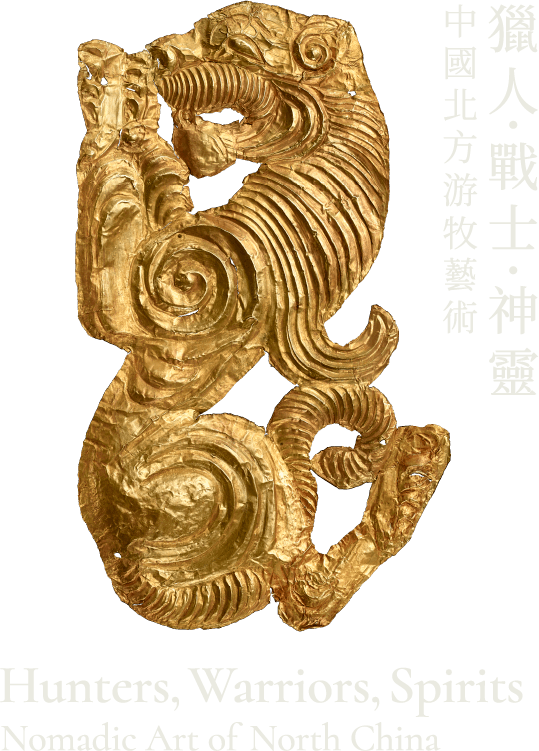Early Nomads in China
Chinese history and the history of Eurasia cannot be understood without looking at the central role played by the nomads. The history of sedentary states from China to Central Europe moulded in large measure by the ebb and flow of their relationships with the nomads, sometimes with one in the ascendancy and sometimes the other. At the same time, sustained contact with the Chinese state gave nomads fresh new insights into political ideology and organization, providing a new model of imperial authority which led to the creation of the earliest “conquest regime” under the Xianbei in North China.
Short Sword with Ornamental Gilt Hilt and Turquoise Inlay
Bronze, gold, turquoise6th century B.C.E
Mengdiexuan Collection
Early Nomads in China
Xiongnu and the Rise of the Nomads
The rise of the Xiongnu in the 3rd century B.C.E. marked the emergence of the first major nomadic empire in northern China and initiated a new chapter in the Hu-Han relations that endured over the next two thousand years. The military threat posed by the Xiongnu encouraged Western Han to seek alliances with the Kushan empire in Bactria (modern-day Afghanistan and northern Pakistan). This, in turn, opened Eurasia to new ideas about art, culture, technology, and science, brought in through a trade route connecting China and the West that came to be known as the Silk Road.
Early Nomads in China
Xianbei’s Transformation of China
The Xianbei were innovators. While their art resembles that of the Xiongnu, it introduces new iconography, such as the “Master (or Mistress) of Animals” motif, where a person is shown simultaneously dominating two animals. Building on earlier paired animal forms, Xianbei designs group the opposing animals around a central object, such as a tree, wheel, animal, or even a human figure (as in the “Master of Animals” motif).
Militarily, the Xianbei were the first to develop heavy cavalry in China, as seen in their terracotta horse sculptures, shown fully armoured. The Xianbei discovered new equestrian technologies which improved their military capability, setting them ahead of other nomadic groups. Selective breeding, for instance, significantly increased the size of their horses (larger than the indigenous Mongol horse), while stirrups enabled the heavily armoured warriors to mount.
Plaque with Warrior, Eagle, and Onager
Gold3rd century B.C.E.
Mengdiexuan Collection
Scabbard Sheet Decorated with Mythical Creatures
Gold leaf5th-3rd century B.C.E.
Mengdiexuan Collection
Plaque with Wrestlers and Horses
Gold2nd–1st century B.C.E.
Mengdiexuan Collection
Pair of Belt Plaques with Eagle Preying on Horse
Gilt bronze, copper2nd century B.C.E. -2nd century C.E.
Hing Chao Collection
Belt Buckles with Tiger Motif
Gilt bronze3rd century C.E.
Mengdiexuan Collection
Xiongnu Rectangular Belt Plaque with Facing Riders
Bronze3rd–2nd century B.C.E.
Hing Chao Collection
Xianbei Archer
Pottery, pigmentNorthern Wei Dynasty (386-534 C.E.)
Stephen Selby Collection
Plaque with Master-of-Animals Motif
Gold3rd-4th century C.E.
H: 6.4 cm x L: 9.2 cm
Mengdiexuan Collection
Pierced Plaques with Motif of Paired-Rams and Wheels
Gold1st-2nd century C.E.
Mengdiexuan Collection
Plaque with Two Facing Wolves
Gold2nd-3rd century C.E.
Mengdiexuan Collection
Northern Qi Armoured, Mounted Warrior Figure
Pottery, pigmentNorthern Qi Dynasty (550-577 C.E.)
Hing Chao Collection
Hunting Scene with Hounds and Bird of Prey
Wood, pigmentNorthern Wei Dynasty (386-534 C.E.)
Stephen Selby Collection


























